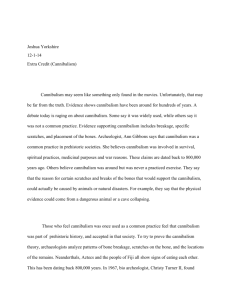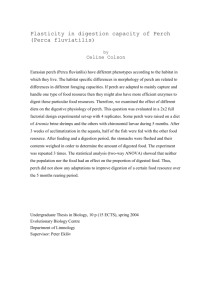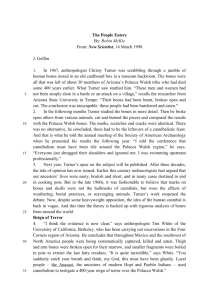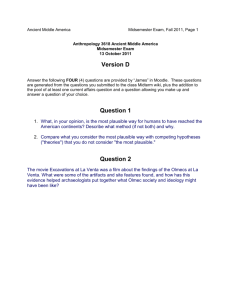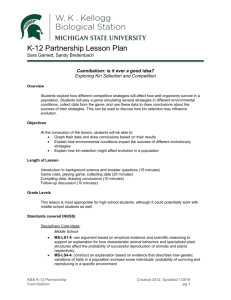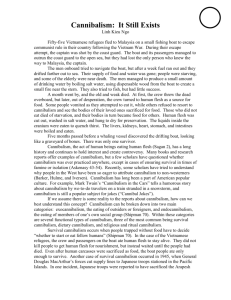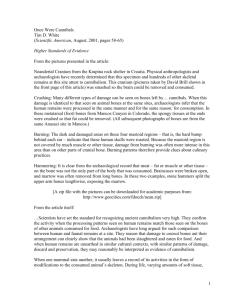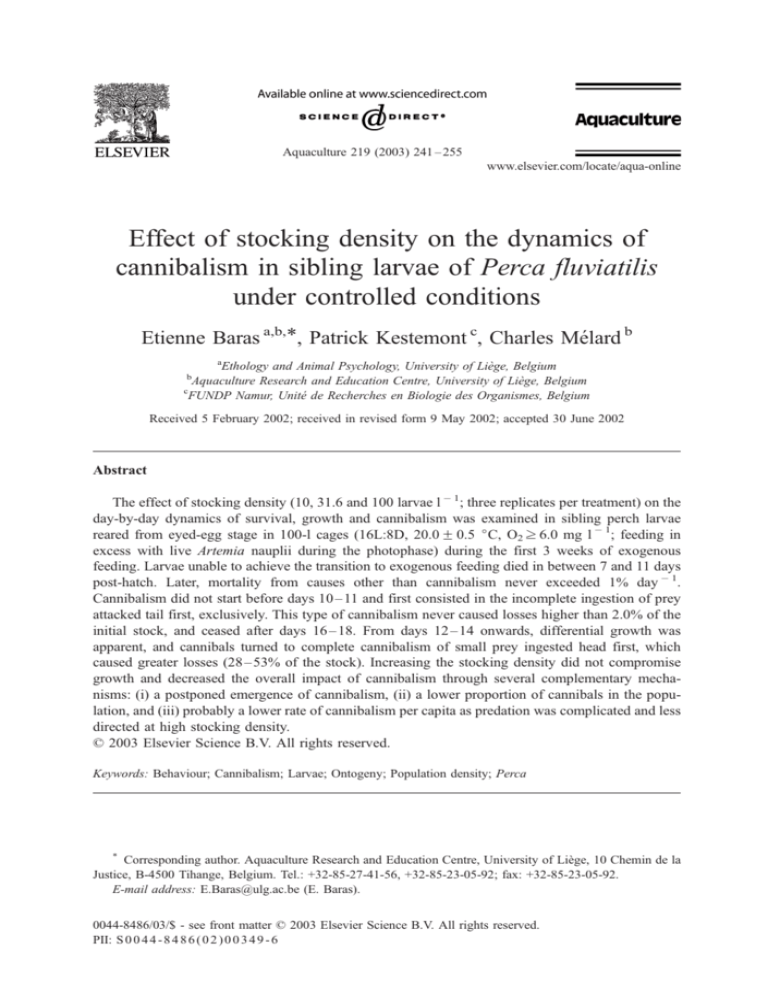
Aquaculture 219 (2003) 241 – 255
www.elsevier.com/locate/aqua-online
Effect of stocking density on the dynamics of
cannibalism in sibling larvae of Perca fluviatilis
under controlled conditions
Etienne Baras a,b,*, Patrick Kestemont c, Charles Mélard b
a
Ethology and Animal Psychology, University of Liège, Belgium
Aquaculture Research and Education Centre, University of Liège, Belgium
c
FUNDP Namur, Unité de Recherches en Biologie des Organismes, Belgium
b
Received 5 February 2002; received in revised form 9 May 2002; accepted 30 June 2002
Abstract
The effect of stocking density (10, 31.6 and 100 larvae l 1; three replicates per treatment) on the
day-by-day dynamics of survival, growth and cannibalism was examined in sibling perch larvae
reared from eyed-egg stage in 100-l cages (16L:8D, 20.0 F 0.5 jC, O2 z 6.0 mg l 1; feeding in
excess with live Artemia nauplii during the photophase) during the first 3 weeks of exogenous
feeding. Larvae unable to achieve the transition to exogenous feeding died in between 7 and 11 days
post-hatch. Later, mortality from causes other than cannibalism never exceeded 1% day 1.
Cannibalism did not start before days 10 – 11 and first consisted in the incomplete ingestion of prey
attacked tail first, exclusively. This type of cannibalism never caused losses higher than 2.0% of the
initial stock, and ceased after days 16 – 18. From days 12 – 14 onwards, differential growth was
apparent, and cannibals turned to complete cannibalism of small prey ingested head first, which
caused greater losses (28 – 53% of the stock). Increasing the stocking density did not compromise
growth and decreased the overall impact of cannibalism through several complementary mechanisms: (i) a postponed emergence of cannibalism, (ii) a lower proportion of cannibals in the population, and (iii) probably a lower rate of cannibalism per capita as predation was complicated and less
directed at high stocking density.
D 2003 Elsevier Science B.V. All rights reserved.
Keywords: Behaviour; Cannibalism; Larvae; Ontogeny; Population density; Perca
*
Corresponding author. Aquaculture Research and Education Centre, University of Liège, 10 Chemin de la
Justice, B-4500 Tihange, Belgium. Tel.: +32-85-27-41-56, +32-85-23-05-92; fax: +32-85-23-05-92.
E-mail address: E.Baras@ulg.ac.be (E. Baras).
0044-8486/03/$ - see front matter D 2003 Elsevier Science B.V. All rights reserved.
PII: S 0 0 4 4 - 8 4 8 6 ( 0 2 ) 0 0 3 4 9 - 6
242
E. Baras et al. / Aquaculture 219 (2003) 241–255
1. Introduction
Cannibalism is a frequent phenomenon in cultured fish (Smith and Reay, 1991; Hecht
and Pienaar, 1993; Folkvord, 1997; Baras, 1998; Baras and Jobling, 2002). It is proportionally more frequent among predatory species than in other taxa (esocids, Bry and Gillet,
1980; Giles et al., 1986; Bry et al., 1992; Kucharczyk et al., 1998; clariids, Hecht and
Appelbaum, 1988; Baras, 1999; characids: Baras et al., 2000; Gomes et al., 2000; percids:
Cuff, 1977, 1980; Loadman et al., 1986; Brabrand, 1995; Mélard et al., 1996a). Larvae
catch prey tail first, swallow them progressively up to the head, which is eventually
discarded (type I cannibalism: Cuff, 1980). Larvae or juveniles that have gained a growth
advantage through the exercise of early cannibalism switch to complete (type II) cannibalism as size heterogeneity develops. Type II cannibalism is ruled by gape-size
limitations and can be mitigated by size-sorting, whereas type I cannibalism is not, and
can be mitigated exclusively through the adjustment of environmental factors (chiefly
stocking density, light, temperature, food and feeding schedule; syntheses in Hecht and
Pienaar, 1993; Baras, 1998; Kubitza and Lovshin, 1999; Baras and Jobling, 2002).
Determining the age of fish at the emergence of cannibalism, the respective impact of
the two types of predation, and the effect of environmental variables on their intensity are
prerequisites to the mitigation of cannibalism in aquaculture. Mitigation of cannibalism is
proportionally more important for species in which artificial reproduction is not practised,
and for which the production of weaned juveniles represents a substantial part of the total
cost of production. Both criteria apply to the Eurasian perch Perca fluviatilis (Tamazouzt
et al., 1994; Mélard et al., 1996b). Smily (1952), Il’ina (1973), Spanovskaya and
Grygorash (1977), Thorpe (1977) and Brabrand (1995) documented the emergence of
cannibalism in perch at an early age. Kestemont et al. (1995) and Mélard et al. (1995,
1996a) reported on its overall impact during the larval and early juvenile stages. Little is
known on the actual growth – survival –cannibalism (hereafter, GSC) dynamics of perch,
except for studies on small samples in experimental environments (Brabrand, 1995).
This study aimed to characterise the GSC dynamics during the larval and early juvenile
stages of the Eurasian perch in production-like conditions, as a function of stocking
density. Considering that temperature and provision of food are set for maximising growth
in aquaculture environments, light-related factors (day length, light intensity, turbidity) and
stocking density are amongst the only factors that can be tailored by aquaculturists. The
influence of stocking density on cannibalism in fish has been highlighted on many
occasions (Li and Mathias, 1982; Degani and Levanon, 1983; Giles et al., 1986; Hecht and
Appelbaum, 1988; van Damme et al., 1989; Haylor, 1991; Kaiser et al., 1995; Mélard et
al., 1996a; Kucharczyk et al., 1998; Baras et al., 1999). Little is known however whether
stocking density affects the emergence of cannibalism, the number of cannibals in the
population and/or the dynamics of cannibalism (Kucharczyk et al., 1998).
2. Material and methods
All fish used in this experiment were siblings originating from a single egg ribbon
(circa 66,500 eggs) spawned by wild breeders in the Lake of Robertville (Eastern
E. Baras et al. / Aquaculture 219 (2003) 241–255
243
Belgium). The ribbon was collected on 30 April 1998, and was transferred into the
experimental hatchery of the Aquaculture Station of the University of Liège (Tihange,
Belgium). Eggs were incubated onto trays at 15– 16 jC until eyes of embryos were visible.
Two days before hatching, four samples of eggs (circa 1 g) were weighed (nearest mg) and
counted in order to determine the mean weight of eggs (8.7 F 0.4 mg), and the survival
rate at this stage ( z 99% in all four samples). On the eve of hatching, nine groups of eggs
were weighed (nearest 0.1 g), and transferred onto trays that were installed inside 100-l
floating cages (mesh size: 100 Am, PVC bottom plate) in an independent recirculating
system at 16 jC. This was done because larvae of perch are more delicate to handle and
count than eggs, especially when regularly arranged in a ribbon. Three stocking densities,
with three replications per treatment, were evaluated, using logarithmic steps between
densities (i.e. 1000, 3163 and 10,000 eggs per cage, hereafter treatments L, M and H [low,
medium and high], respectively).
Within the first 24 h, water temperature was warmed progressively from 16.0 to
20.0 F 0.5 jC, then was automatically regulated at this value for the rest of the
experiment. The illumination regime was set at 16L:8D (light from 0600 to 2200 h),
after Jourdan (1999) demonstrated the positive correlation between day length and the
survival of perch larvae. The trays were removed when all embryos had hatched (delay
between earliest and latest hatching eggs: 49 h; mean body weight of embryos: 0.85 mg).
Food distribution started on the next day (hereafter, day 1) and extended over 3 weeks.
Larvae were fed in excess with live brine shrimp nauplii (45.2% protein, 21% lipid
content) that were distributed with a peristaltic pump (Watson Marlow, model 202 S)
during daylight hours (10 periods of 10 min at 90-min intervals, starting from 0800 h).
The food rations were incremented each day (i.e. from 1 mg per fish on day 1 to 80 mg
per fish on day 21), in order that fish were fed in excess throughout the experiment. In
between the first two feeding periods of each day, the bottom plate of each cage was
siphoned. Dead fish were separated from faeces and wasted feed. Tail-off larvae or fish
heads were regarded as victims of type I cannibalism, and were counted separately from
other dead fish.
On feeding days 7 and 14, a sample of 25 (L) or 50 fish (M and H) was collected
in each cage in order to measure size heterogeneity. On day 22, no food was
distributed. The cages were emptied and all surviving larvae were counted. A sample
of 100 randomly selected fish was measured in each group when the number of
survivors exceeded this value. All large (i.e. about twice the size of the smallest fish
within the sample; Brabrand, 1995; Mélard et al., 1996a) individuals, which were
deemed to have cannibalistic tendencies, were counted and measured individually to
the nearest 0.1 mg. Additional samples of live fish were collected in 2-l buckets on
days 7, 14 and 18 in order to estimate the survival rates until these days. The volume
of water was measured to the nearest 0.01 l, then fish were counted and released into
the cages (three samples per cage).
The losses to type II cannibalism were calculated as follows. The theoretical survival
rate was obtained by subtracting from the initial number of fish, the running sums of dead
fish (both intact and truncated) collected each day. The actual survival rate was estimated
from volumetric estimates (days 7, 14 and 18) or counts (day 22) of survivors. Type II
cannibalism was deemed to have started when the former was outside the 95% confidence
244
E. Baras et al. / Aquaculture 219 (2003) 241–255
interval of the latter. The effect of stocking density on mortality, type I and type II
cannibalism, and the proportion of cannibals at the end of the study was analysed by
contingency table analysis. The body weights of perch larvae on days 7, 14 and 21 were
compared with one-way analyses of variance (ANOVA) and Scheffe F-tests. Null
hypotheses were rejected at P < 0.05.
3. Results
At the end of the study, survival was significantly higher at the highest stocking
density (H, Table 1). All fish in cage L3 died within the first 20 rearing days (Fig. 1),
possibly as a result of a pathological outbreak, and this group was not taken into
account for any statistical comparison in this article. Except for this, mortality showed
unimodal dynamics, with a sharp peak (8.5 – 17.6% day 1) on day 7 or 8, and a
curvilinear decrease until day 11 or 12. Frequency distributions of fish body weight on
day 7 were bimodal, with about 30% of the fish showing no weight gain since
hatching (Fig. 2). Most dead larvae collected from day 7 to day 12 had slender bodies
and weighed less than 1.0 mg. The frequency distributions of fish body weights on day
14 had become unimodal, and contained no or very few fish weighing less than 1 mg.
These observations support the idea that mortality during this period affected
essentially the smallest individuals, which were probably nonfeeders. Beyond day
12, these losses were always < 1.0% day 1, except in cage L3. Over the 21-day
Table 1
Effect of stocking density on the mortality, cannibalism and growth of sibling perch reared over 21 days in 100-l
floating cages at 20.0 F 0.5 jC under 16L:8D
Density
Low (L)
Medium (M)
High (H)
Initial numbers of eggs (Ni)
Final numbers of juveniles (Nf)
Total survival (%)
Losses to type I cannibalism (% Ni)
Losses to type II cannibalism (% Ni)
‘Natural’ mortality (% Ni)
Cannibals (N) on day 21
(xNi)
(xNf)
Body weight (mean, mg F CV%)
day 7
day 14
day 22 (non-cannibal fish)
day 22 (cannibals)
1000
148 F 24
14.75 F 2.35a
1.40 F 0.30a
53.15 F 9.25a
30.70 F 6.60a
3.0 F 0.0a
3.0 F 0.0a
20.9 F 3.3a
3163
596 F 147
18.87 F 4.64ab
1.50 F 0.20a
28.04 F 3.04b
51.65 F 4.50b
4.3 F 1.2b
1.4 F 0.4b
9.0 F 4.5b
10,000
2014 F 571
20.14 F 5.71b
1.39 F 0.75a
34.37 F 8.29ab
44.10 F 5.66ab
6.0 F 3.2ab
0.6 F 0.3c
4.2 F 2.4b
1.2 ( F 57.07%)a
4.0 ( F 57.02%)a
7.3 ( F 46.22%)a
51.2 ( F 25.13%)a
1.2 ( F 46.94%)a
3.5 ( F 46.07%)a
9.7 ( F 43.11%)b
74.5 ( F 40.14%)b
1.6 ( F 46.22%)b
4.3 ( F 53.92%)a
11.2 ( F 36.48%)c
68.1 ( F 24.19%)ab
Except when additional precision is given, values are means F S.E.M. of three replicates. For each line of the
table, values sharing one common superscript are not significantly different whereas other comparisons differ at
P < 0.05 (contingency table analyses for survival and cannibalism, ANOVA and Scheffe F-tests for body
weights). Ni and Nf are the initial and final (day 22) numbers of fish, respectively. CV is the coefficient of
variation.
E. Baras et al. / Aquaculture 219 (2003) 241–255
245
Fig. 1. Variation of daily rates of type I cannibalism (closed circles) and mortality from starvation or other causes (open triangles) among sibling larvae of Eurasian perch,
depending on stocking density. Ni is the initial of eggs (100-l floating cages at 20.0j F 0.5 jC, under 16L:8D), and day 0 is the time when all embryos had hatched.
246
E. Baras et al. / Aquaculture 219 (2003) 241–255
E. Baras et al. / Aquaculture 219 (2003) 241–255
247
rearing period, deaths from causes other than cannibalism amounted to over 30% of
the initial stock in all three treatments, with the highest impact in treatment M (51.7%,
Table 1).
Truncated fish were observed first on day 11, suggesting that type I cannibalism had not
been exerted by larvae younger than 10 days. It peaked in between days 12 and 15, then
vanished in most groups after day 16. A notable exception to this pattern was group H2,
which showed the lowest mortality rate of all groups, and where type I cannibalism
persisted until the end of the experiment (Fig. 1). On average, losses to type I cannibalism
were low ( V 1.5% of initial stock), and did not differ significantly between stocking
densities (Table 1). However, type I cannibalism emerged, and peaked slightly earlier in
treatments L compared to treatments M and H (Figs. 3 and 4).
Volumetric counts of the numbers of perch on days 7 and 14 were consistent with
the numbers of survivors that were estimated from losses to mortality and to type I
cannibalism, suggesting that type II cannibalism had been insignificant until this age
(Fig. 3). By contrast, counts on days 18 and 22 were significantly lower than the
estimated numbers of survivors, suggesting that type II cannibalism had started
becoming intense in between days 14 and 18. This conclusion is supported by the
finding that the coefficient of variation (CV) of the mean body weight was high until
day 14 inclusive, and decreased from day 14 to day 22 (Table 1), when the smallest
individuals were removed from the population by the cannibals. It is also supported by
some observations of suffocated cannibals, with the head of the prey stuck in their gut,
from day 16 onwards (exclusively in groups H1 and H3). This was seen in all cages,
except for H2, where type I cannibalism was still intense on these days. As was seen
with type I cannibalism, type II cannibalism started earlier at low stocking density than
in other groups. This was probably the reason why the total loss to type II cannibalism
in treatments L was greater than in treatments M and H. Similarly, the final (day 22)
proportions of large juveniles deemed to have cannibalistic tendencies differed
significantly between treatments, and were inversely proportional to stocking density
(Table 1). It is worth noticing that no single fish of group H2 was identified as a
potential cannibal, despite the fact that the impact of type II cannibalism was estimated
at 23.2% of the initial stock in this particular group. This apparent paradox could be
due to cannibals ‘tracking the population’, and consuming prey as soon as they were
proportionally small enough to be consumed.
Perch larvae grew at a relatively slow rate in all groups ( < 13% day 1). Nevertheless,
growth rates and size heterogeneity were significantly influenced by the initial stocking
density. Final body weight was greater and size heterogeneity was lower in treatments H
than in other treatments (Table 1). No such differences were seen on days 7 and 14,
Fig. 2. Body weight frequency distributions of perch larvae aged 7, 14 and 21 days, depending on stocking
density. Values are the means of three replicates for the three stocking densities. Distributions on days 7 and 14
were obtained from one sample of 25 (Ni = 1000) or 50 fish (Ni z 3163) in each group, whereas the distributions
on day 22 took into account all surviving fish, except for the individuals assumed to be potential cannibals
(Table 1). Closed bars on graphs at day 7 are fish showing no positive growth, and deemed to starve during the
next days.
248
E. Baras et al. / Aquaculture 219 (2003) 241–255
E. Baras et al. / Aquaculture 219 (2003) 241–255
249
Fig. 4. Dynamics of mortality and cannibalism (I = incomplete ingestion, II = complete ingestion) during the
ontogeny of perch, depending on stocking density. Values and error bars are the means F S.E.M. of three
replicates.
suggesting that most of the differences emerged during the period when type II cannibalism was most intense (days 14 –21).
4. Discussion
As in other percomorphs (e.g. striped bass Morone saxatilis, Tsai, 1991), a substantial
proportion of perch larvae is unable to prey on Artemia nauplii, and requires smaller food
items (e.g. rotifers, small size Artemia; Mélard et al., 1996a; Vlavonou et al., 1999).
Kestemont et al. (1996) estimated that this proportion ranged from 30% to 40%. Jourdan
Fig. 3. Comparison between the survival rates of perch larvae, as estimated from the daily counts of dead larvae
and victims of type I cannibalism (closed squares), and those deduced from volumetric estimates (open squares;
days 7, 14, 18) or fish counts (day 22). Volumetric estimates of the number of survivors were obtained from three
samples of circa 2 l in each group. Error bars are the 95% confidence intervals of volumetric estimates. A
difference between the two estimates indicates that type II cannibalism has caused significant losses since the last
examination.
250
E. Baras et al. / Aquaculture 219 (2003) 241–255
(1999) and Vlavonou et al. (1999) reported that perch larvae that were apparently unable
to feed on Artemia nauplii died in between 6 and 11 day post-hatch, and similar mortality
dynamics were obtained during starvation experiments at the same temperature as here
(Abi-Ayad, 1998). This supports the idea that the early mortality of perch larvae during
this study reflected small fish dying of hunger. Beyond day 11, cannibalism contributed
presumably to eliminating the few remaining individuals weakened by starvation.
Cannibalistic behaviour in this experiment was observed first in 10-day-old fish. This is
consistent with the findings of Brabrand (1995), who stated that perch do not exert
cannibalism at larval stage IV (7.2 mm and < 2 mg; after the classification of Konstantinov, 1957), whereas they do from larval stage V (10.5 mm and 6 mg) onwards. This is
much earlier than in most other temperate species (e.g. pike Esox lucius; Giles et al., 1986;
Bry et al., 1992; koi carp Cyprinus carpio, van Damme et al., 1989; sea bass
Dicentrarchus labrax, Katavic et al., 1989; yellowtail Seriola quinqueradiata, Sakakura
and Tsukamoto, 1996), but slightly later than in other percids (walleye Stizostedion
vitreum: Cuff, 1977; Loadman et al., 1986) and percichtyids (striped bass M. saxatilis:
Braid and Shell, 1981) at similar temperatures.
Brabrand (1995) observed that perch could consume siblings tail first or head first.
Here, perch larvae started consuming their prey tail first exclusively, probably because size
heterogeneity was initially low, and did not permit cannibals to find prey that were small
enough to be swallowed whole. Later, size heterogeneity increased, partly as a result of
early cannibalism. Fish prey have a higher content of digestible nutrients than plankton
prey (Meffe and Crump, 1987; Kubitza and Lovshin, 1999), so fish feeding totally or
partly on conspecifics generally grow faster than those feeding exclusively on plankton
prey (Baras and Jobling, 2002), and this is precisely the case in the Eurasian perch
(Brabrand, 1995). Increasing size heterogeneity facilitated the exercise of type II cannibalism, which is determined by gape-size limitations. The reasons behind the abandonment of
type I cannibalism in the Eurasian perch are probably manifold, and similar to those
invoked for other species: a greater difficulty of capturing tail first prey with increasing
swimming capacities (e.g. Li and Mathias, 1982) and a greater risk of exposure to other
cannibals (e.g. Baras et al., 2000) or kleptoparasites (e.g. Nilsson and Bronmark, 1998)
when prey increase in size. Brabrand (1995) precisely found that cannibals of Eurasian
perch were less successful while trying to catch their prey tail first. Another reason behind
the shift to complete cannibalism in perch and other Acanthopterygians is the development
of spiny fin-rays. As soon as spiny rays develop, prey can no longer be ingested tail first to
avoid damage the mouth and gut of the cannibals. This implies that prey are smaller
relative to cannibals than were those for type I cannibalism, and that the per capita impact
of cannibalism increases after the shift to type II cannibalism (see also Baras, 1999; Baras
et al., 2000). The earlier the emergence of type I cannibalism, the earlier the increase in
size heterogeneity and shift to type II cannibalism, and the greater the overall impact of
cannibalism. This functional interpretation accounts for why cannibalism was more
intense at the lowest stocking density, where type I cannibalism emerged earlier than at
higher stocking densities.
The negative correlation between stocking density and growth in perch at high stocking
density is consistent with the results of large-scale ‘black-box’ experiments by Mélard et
al. (1996a), and can be accounted for by several complementary factors. Uematsu and
E. Baras et al. / Aquaculture 219 (2003) 241–255
251
Takamori (1976) put forward the role of social facilitation of feeding in the medaka
Oryzias latipes (i.e. greater amounts of food consumed by individuals at higher stocking
density). Hecht and Uys (1997) found that sharptooth catfish consumed less food when
stocked at low density, and they hypothesised that the motivation to maintain a territory
was stronger than the motivation to forage in these circumstances. Similar considerations
may apply here: perch larvae were observed shoaling at the intermediate and high stocking
density, whereas they were dispersed at the lowest stocking density. Whichever the exact
reason, increasing the stocking density resulted in faster growth and lower size heterogeneity (see also Grant, 1993, 1997 for a discussion on the effect of density on dominance
hierarchies, and Kestemont et al., in press for a review of factors that affect size heterogeneity among Eurasian perch larvae).
An increase in stocking density results in a greater probability of encounter between a
cannibal and potential prey. In species or life stages that exert a contact-and-consume
predation, this leads to increased cannibalism (e.g. walleye: Cuff, 1980; Li and Mathias,
1982; Loadman et al., 1986; catfishes: Haylor, 1991; characids: Baras et al., 2000; Gomes
et al., 2000). In visually orientated species, cannibalism can be complicated when the
predator is confronted to a large number of targets, which may cause a perceptual
confusion effect and make prey selection less efficient. For example, Kucharczyk et al.
(1998) observed that the cannibalistic attacks of northern pike were less successful when
population density was high. The confusion brought about by the multiplicity of targets
may also cause predators to misestimate the relative size of their prey and direct their
attacks towards prey that are slightly too large for their gape. Perch possesses spiny finrays that make regurgitation impossible, so cannibals that consume excessively large prey
eventually suffocate. The finding that suffocated perch cannibals were observed at the
highest stocking density exclusively, supports this interpretation.
Cannibals at high stocking density probably had a lower impact per capita and could
exert cannibalism over a shorter period than at lower densities. The number of fish
identified as cannibals at the end of the study was proportional to stocking density, but the
proportion of cannibals relative to the initial number of fish was negatively correlated to
stocking density. A similar relationship was observed by Mélard et al. (1996a), who
hypothesised that a minimum territory size was necessary for the expression of type II
cannibalism. As a corollary, the maximum number of cannibals that can be ‘hosted’ by an
environment is strongly influenced by the dimensions of the environment, so increasing
the initial stocking density may serve to reduce the proportion of cannibals, and thus the
impact of cannibalism. The latter argument should be considered with caution, at least
when the proportion of cannibals is determined from the examination of size distributions
at the end of a rearing period. Such an information is of great value for predicting
forthcoming cannibalism, but is of limited value for understanding how intense cannibalism has been until then (Baras and Jobling, 2002). Cannibalism impacts on size
heterogeneity, and group H2, where no single fish was identified as a cannibal despite
cannibalism had eliminated over 30% of the stock, is a good example of this.
All in all, cannibalism caused the elimination of 29.5% to 54.5% of the initial stock,
depending on stocking density. These losses are higher than in a series of other experiments
with perch. We cannot rule out the hypothesis that cannibalism had been facilitated by the
hatching time extending over 49 h in this experiment. Differential hatching generally results
252
E. Baras et al. / Aquaculture 219 (2003) 241–255
in greater initial size heterogeneity, which is likely to facilitate cannibalism (e.g. larvae of
sharptooth catfish Clarias gariepinus; Baras and d’Almeida, 2001). However, Kestemont et
al. (in press) report that cannibalism in perch is as intense among siblings hatched within 24
h as among siblings hatched over 48 h. The difference between perch and other fish species
in which differential hatching has been found to influence cannibalism, probably relates to
the times of emergence of cannibalism with respect to the dynamics of mortality of starving
fish (Baras and Jobling, 2002). If cannibalism starts early during the ontogeny, small or
deformed fish are the trigger to cannibalism. On the contrary, if cannibalism starts after
small or deformed larvae have starved, as is the case for perch, initial size heterogeneity has
less influence on the dynamics of cannibalism. Instead, it is probable that cannibalism in
this particular experiment has been facilitated by young perch being fed exclusively with
brine shrimp nauplii, which have a lower energy content than formulated feed (Kubitza and
Lovshin, 1999; Lee and O’Bryen, 2001). Cannibals obtain a proportionally greater
advantage over siblings feeding on brine shrimp than over those feeding on formulated
feed (Baras and Jobling, 2002), so cannibalism can cause greater losses if the distribution of
plankton prey is prolonged for longer than necessary.
5. Conclusion
This study provided evidence that the decrease of cannibalism among perch under
increasing stocking density resulted from a combination of factors (lower proportion of
cannibals, lower per capita impact, delayed emergence of cannibalism). This finding,
together with the observation that type I cannibalism—which cannot be mitigated by size
grading—has a minor impact in perch, is an encouraging result for the development of
perch aquaculture. Nevertheless, type II cannibalism in perch may become intense at an
age (14 – 18-day post-hatch) and size ( < 20 mm) when fish are still too small for manual or
mechanical size-sorting. Future research efforts should aim at improving the growth of
perch during the early life stages, as this would postpone the onset of complete cannibalism and enable aquaculturists to sort fish at a younger age, thereby decreasing the
overall losses to cannibalism. Formulated feed has a higher energy content than plankton
prey, and the determination of the cut-off sizes or age at which perch larvae can be weaned
is a priority, for reducing both cannibalism and feeding costs. In view of the dynamics of
cannibalism observed here, it would be worthwhile to try weaning perch larvae at 14 –16day post-hatch at 20 jC, since this is the time when type II cannibalism starts becoming
intense. Preliminary experiments indicate that this is indeed feasible and that it yields
survival and growth rates similar to, or better than those of fish weaned at an older age
(Gielen et al., unpublished).
Acknowledgements
This study was part of European Union contract FAIR CT96-1572 (DG XII-XIV/C2).
The authors wish to thank Electrabel for supporting the fish culture programmes at the
University of Liège. E. Baras is a research associate of the Belgian FNRS.
E. Baras et al. / Aquaculture 219 (2003) 241–255
253
References
Abi-Ayad, S.M.E.A., 1998. Etude expérimentale de la biologie de la reproduction de la perche fluviatile (Perca
fluviatilis). Effet de la composition en acides gras de la série (n-3) de l’alimentation sur la qualité des œufs et
des larves. PhD Thesis, University of Liège, 147 pp.
Baras, E., 1998. Biological bases of cannibalism in fish. Cah. Éthol. 18, 53 – 98 (Fr).
Baras, E., 1999. Sibling cannibalism among juvenile vundu under controlled conditions: I. Cannibalistic behaviour, prey selection and prey size-selectivity. J. Fish Biol. 54, 82 – 105.
Baras, E., d’Almeida, A.F., 2001. Size heterogeneity prevails over kinship in shaping cannibalism among larvae
of sharptooth catfish Clarias gariepinus. Aquat. Living Resour. 14, 251 – 256.
Baras, E., Jobling, M., 2002. Dynamics of intracohort cannibalism in cultured fishes. Aquac. Res. 33,
461 – 479.
Baras, E., Tissier, F., Philippart, J.-C., Mélard, C., 1999. Sibling cannibalism among juvenile vundu under
controlled conditions: II. Effect of body weight and environmental variables on periodicity and the intensity
of type II cannibalism. J. Fish Biol. 54, 106 – 118.
Baras, E., Ndao, M., Maxi, M.Y.J., Jeandrain, D., Thomé, J.-P., Vandewalle, P., Mélard, C., 2000. Sibling
cannibalism in dorada under experimental conditions: I. Ontogeny, dynamics, bioenergetics of cannibalism
and prey size selectivity. J. Fish Biol. 57, 1001 – 1020.
Brabrand, Å., 1995. Intracohort cannibalism among larval stages of perch (Perca fluviatilis). Ecol. Freshw. Fish 4,
70 – 76.
Braid, M.R., Shell, E.W., 1981. Incidence of cannibalism among striped bass fry in an intensive culture system.
Prog. Fish-Cult. 43, 210 – 212.
Bry, C., Gillet, C., 1980. Réduction du cannibalisme précoce chez le brochet (Esox lucius) par isolement des
fratries. Bull. Fr. Piscic. 277, 142 – 153.
Bry, C., Basset, E., Rognon, X., Bonamy, F., 1992. Analysis of sibling cannibalism among pike, Esox lucius,
juveniles reared under semi-natural conditions. Environ. Biol. Fishes 35, 75 – 84.
Cuff, W.R., 1977. Initiation and control of cannibalism in larval walleyes. Prog. Fish-Cult. 39, 29 – 32.
Cuff, W.R., 1980. Behavioral aspects of cannibalism in larval walleye, Stizostedion vitreum. Can. J. Zool. 58,
1504 – 1507.
Degani, G., Levanon, D., 1983. The influence of low density on food adaptation, cannibalism and growth of eels
(Anguilla anguilla (L.)). Bamidgeh 35, 53 – 60.
Folkvord, A., 1997. Ontogeny of cannibalism in larval and juvenile fishes with special emphasis on Atlantic cod.
In: Chambers, R.C., Trippel, E.A. (Eds.), Early Life History and Recruitment in Fish Populations. Chapman &
Hall, London, pp. 251 – 278.
Giles, N., Wright, R.M., Nord, M.E., 1986. Cannibalism in pike fry, Esox lucius L.: some experiments with fry
densities. J. Fish Biol. 29, 107 – 113.
Gomes, L.C., Baldisserotto, B., Senhorini, J.A., 2000. Effect of stocking density on water quality, survival, and
growth of larvae of the matrinxã, Brycon cephalus (Characidae), in ponds. Aquaculture 183, 73 – 81.
Grant, J.W.A., 1993. Whether or not to defend? The influence of resource distribution. Mar. Behav. Physiol. 23,
137 – 153.
Grant, J.W.A., 1997. Territoriality. In: Godin, J.-G.J. (Ed.), Behavioural Ecology of Teleost Fishes. Oxford Univ.
Press, Oxford, pp. 81 – 103.
Haylor, G.S., 1991. Controlled hatchery production of Clarias gariepinus (Burchell, 1822): growth and survival
of fry at high stocking density. Aquac. Fish. Manage. 22, 405 – 422.
Hecht, T., Appelbaum, S., 1988. Observations on intraspecific aggression and coeval sibling cannibalism by
larval and juvenile Clarias gariepinus (Clariidae: Pisces) under controlled conditions. J. Zool. (Lond.) 214,
21 – 44.
Hecht, T., Pienaar, A.G., 1993. A review of cannibalism and its implication in fish larviculture. J. World Aquac.
Soc. 24, 246 – 261.
Hecht, T., Uys, W., 1997. Effect of density on the feeding and aggressive behaviour in juvenile African catfish,
Clarias gariepinus. S. Afr. J. Sci. 93, 537 – 541.
Il’ina, L.K., 1973. Behaviour of perch (Perca fluviatilis L.) underyearlings of different ecological groups in the
progeny of a single pair of spawners. J. Ichthyol. 13, 294 – 304.
254
E. Baras et al. / Aquaculture 219 (2003) 241–255
Jourdan, S., 1999. Influences de facteurs abiotiques, la photopériode et l’intensité lumineuse, sur la survie et la
croissance de larves, post-larves et juvéniles de perche commune Perca fluviatilis L. PhD Thesis, Institut
National Polytechnique de Lorraine, Nancy, France, 145 pp.
Kaiser, H., Weyl, O., Hecht, T., 1995. The effect of stocking density on growth, survival and agonistic behaviour
of African catfish. Aquac. Int. 3, 217 – 225.
Katavic, I., Jug-Dujakovic, J., Glamuzina, B., 1989. Cannibalism as a factor affecting the survival of intensively
cultured sea bass (Dicentrarchus labrax) fingerlings. Aquaculture 77, 135 – 143.
Kestemont, P., Fiogbé, E., Parfait, O., Micha, J.-C., Mélard, C., 1995. Relationship between weaning size, growth
and cannibalism in the common perch larvae, Perca fluviatilis: a preliminary approach. In: Lavens, P., Jaspers,
E., Roelants, I. (Eds.), Larvi’95: Fish and Shellfish Aquaculture Symposium, vol. 24. European Aquaculture
Society, Ghent, pp. 251 – 278. Spec. Publ.
Kestemont, P., Mélard, C., Fiogbé, E., Vlavonou, R., Masson, G., 1996. Nutritional and animal husbandry aspects
of rearing early life stages of Eurasian perch. J. Appl. Ichthyol. 12, 157 – 165.
Kestemont, P., Jourdan, S., Houbart, M., Mélard, C., Paspatis, M., Fontaine, P., Cuvier, A., Kentouri, M., Baras,
E., in press. Size heterogeneity, cannibalism and competition in cultured predatory fish larvae: biotic and
abiotic influences. Aquaculture.
Konstantinov, K.G., 1957. Comparative analysis of morphology and biology of perch, pikeperch, Volga pikeperch
of different stages of development. Rep. Inst. Evol. Morph. Anim. 16, 181 – 236.
Kubitza, F., Lovshin, L.L., 1999. Formulated diets, feeding strategies and cannibalism during intensive culture of
juvenile carnivorous fishes. Rev. Fish. Sci. 7, 1 – 22.
Kucharczyk, D., Mamcarz, A., Kujawa, R., Skrzypczask, A., 1998. Development of cannibalism in larval northern pike, Esox lucius (Esocidae). Ital. J. Zool. 65, 261 – 263. Suppl.
Lee, C.-S., O’Bryen, P.J. (Eds.), 2001. Advanced Biotechnology in Hatchery Production. Aquaculture, vol. 200,
pp. 1 – 250.
Li, S.K., Mathias, J.A., 1982. Causes of high mortality among cultured larval walleyes. Trans. Am. Fish. Soc.
111, 710 – 721.
Loadman, N.L., Moodie, G.E.E., Mathias, J.A., 1986. Significance of cannibalism in larval walleye (Stizostedion
vitreum). Can. J. Fish. Aquat. Sci. 43, 613 – 618.
Meffe, G.K., Crump, M.L., 1987. Possible growth and reproductive benefits of cannibalism in mosquitofish. Am.
Nat. 129, 203 – 212.
Mélard, C., Kestemont, P., Baras, E., 1995. Preliminary results of European perch (Perca fluviatilis)
intensive rearing trials: effect of temperature and size grading on growth. Bull. Fr. Pêche Piscic.
336, 19 – 27.
Mélard, C., Baras, E., Mary, L., Kestemont, P., 1996a. Relationships between growth, cannibalism and
survival rate in intensively cultured larvae and alevins of perch (Perca fluviatilis). Ann. Zool. Fenn.
33, 643 – 651.
Mélard, C., Kestemont, P., Grignard, J.C., 1996b. Intensive culture of juvenile and adult Eurasian perch (P.
fluviatilis): effect of major biotic and abiotic factors on growth. J. Appl. Ichthyol. 12, 175 – 180.
Nilsson, P.A., Bronmark, C., 1998. Foraging among cannibals and kleptoparasites: effects of prey size on pike
behavior. Behav. Ecol. 10, 557 – 566.
Sakakura, Y., Tsukamoto, K., 1996. Onset and development of cannibalistic behaviour in early life stages of
yellowtail. J. Fish Biol. 48, 16 – 29.
Smily, W.J.P., 1952. Observations on the food of the fry of perch, Perca fluviatilis L. in Windermere. Proc. Zool.
Soc. Lond. 122, 407 – 416.
Smith, C., Reay, P., 1991. Cannibalism in teleost fishes. Rev. Fish Biol. Fish. 1, 41 – 64.
Spanovskaya, V.D., Grygorash, V.A., 1977. Development and food of age-0 Eurasian perch (Perca fluviatilis) in
reservoirs near Moscow, USSR. J. Fish. Res. Board Can. 34, 1551 – 1558.
Tamazouzt, L., Dubois, J.P., Fontaine, P., 1994. Production et marché actuels de la perche (Perca fluviatilis) en
Europe. Piscic. Fr. 114, 4 – 8.
Thorpe, J., 1977. Synopsis of biological data on the perch Perca fluviatilis (Linnaeus, 1758) and Perca flavescens
(Mitchill, 1814). FAO Fish. Synop. 13, 138 pp.
Tsai, C., 1991. Prey density requirements of the striped bass, Morone saxatilis (Walbaum) larvae. Estuaries 14,
207 – 217.
E. Baras et al. / Aquaculture 219 (2003) 241–255
255
Uematsu, T., Takamori, J., 1976. Social facilitation in feeding behaviour of the medaka, Oryzias latipes: 1.
Continuous observation during a short period. Jpn. J. Ecol. 26, 135 – 140.
van Damme, P., Appelbaum, S., Hecht, T., 1989. Sibling cannibalism in koi carp, Cyprinus carpio L., larvae and
juveniles reared under controlled conditions. J. Fish Biol. 34, 855 – 863.
Vlavonou, R.S., Masson, G., Moreau, J.C., 1999. Growth of Perca fluviatilis larvae fed with Artemia spp. nauplii
and the effects of initial starvation. J. Appl. Ichthyol. 15, 29 – 33.

